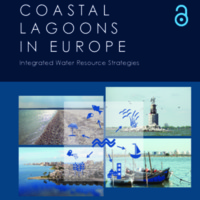Coastal Lagoons in Europe: Integrated Water Resource Strategies
Dublin Core
Description
Lagoons represent nearly 13% of the shoreline globally and around 5% in Europe. Coastal lagoons are shallow water bodies separated from the ocean by a barrier (e.g., narrow spit), connected at least intermittently to the ocean by one or more restricted inlets, and usually geographically oriented parallel to the shore-line. Coastal lagoons are flexible and usually able to cope with environmental change, yet nowadays they are under threat. This is partly due to climate change impacts (for example, sea-level rise and hydro-meteorological extreme events) but also due to more direct human activities and pressures.
The book focuses on addressing these challenges through integrated management strategies seen in a land-sea and science-stakeholder-policy perspective. Pan-European management challenges are seen from the context of the perspectives of Policy, Environment and Modelling. Four case study lagoons in different geographical locations in Europe provide examples of some of the practical experiences and results around these challenges. Possible impacts on drainage basins and lagoons are introduced through integrated scenarios which were developed through a multi-science and land-lagoon science perspective combined with interactions and contributions from stakeholders and citizens.
The book focuses on addressing these challenges through integrated management strategies seen in a land-sea and science-stakeholder-policy perspective. Pan-European management challenges are seen from the context of the perspectives of Policy, Environment and Modelling. Four case study lagoons in different geographical locations in Europe provide examples of some of the practical experiences and results around these challenges. Possible impacts on drainage basins and lagoons are introduced through integrated scenarios which were developed through a multi-science and land-lagoon science perspective combined with interactions and contributions from stakeholders and citizens.
Publisher
Contributor
Cut Rita Zahara
Rights
Creative Commons
Type
Files
Citation
“Coastal Lagoons in Europe: Integrated Water Resource Strategies,” Open Educational Resources (OER) , accessed January 13, 2026, http://oer.uinsyahada.ac.id/items/show/364.


